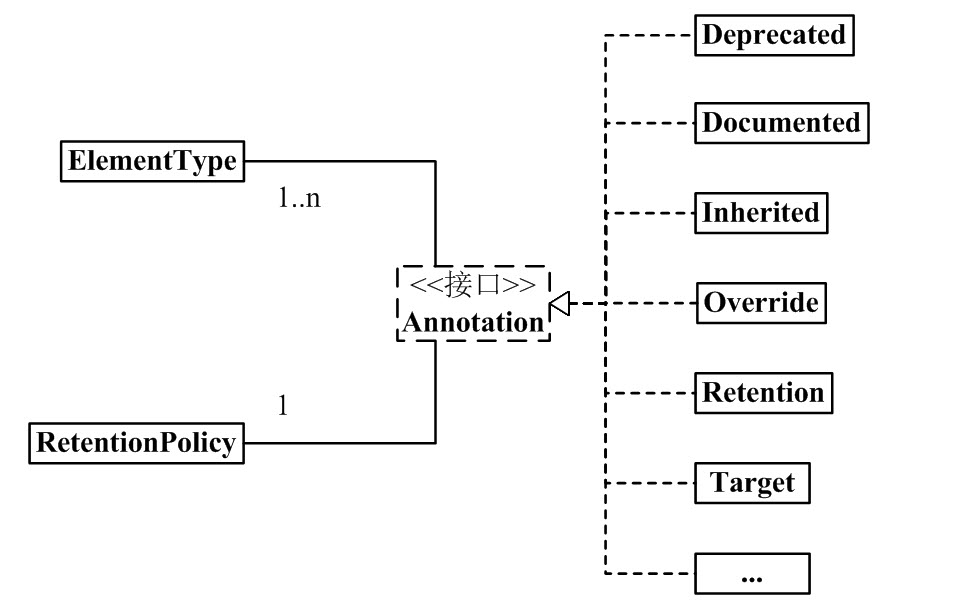一、概念
Annontation是Java5开始引入的新特征。中文名称一般叫注解。它提供了一种安全的类似注释的机制,用来将任何的信息或元数据(metadata)与程序元素(类、方法、成员变量等)进行关联。
更通俗的意思是为程序的元素(类、方法、成员变量)加上更直观更明了的说明,这些说明信息是与程序的业务逻辑无关,并且是供指定的工具或框架使用的。Annontation像一种修饰符一样,应用于包、类型、构造方法、方法、成员变量、参数及本地变量的声明语句中。
二、原理
Annotation其实是一种接口。通过Java的反射机制相关的API来访问annotation信息。相关类(框架或工具中的类)根据这些信息来决定如何使用该程序元素或改变它们的行为。
annotation是不会影响程序代码的执行,无论annotation怎么变化,代码都始终如一地执行。
Java语言解释器在工作时会忽略这些annotation,因此在JVM 中这些annotation是“不起作用”的,只能通过配套的工具才能对这些annontaion类型的信息进行访问和处理。
Annotation与interface的异同:
1)、Annotation类型使用关键字@interface而不是interface。
这个关键字声明隐含了一个信息:它是继承了java.lang.annotation.Annotation接口,并非声明了一个interface
2)、Annotation类型、方法定义是独特的、受限制的。
Annotation 类型的方法必须声明为无参数、无异常抛出的。这些方法定义了annotation的成员:方法名成为了成员名,而方法返回值成为了成员的类型。而方法返回值类型必须为primitive类型、Class类型、枚举类型、annotation类型或者由前面类型之一作为元素的一维数组。方法的后面可以使用 default和一个默认数值来声明成员的默认值,null不能作为成员默认值,这与我们在非annotation类型中定义方法有很大不同。
Annotation类型和它的方法不能使用annotation类型的参数、成员不能是generic。只有返回值类型是Class的方法可以在annotation类型中使用generic,因为此方法能够用类转换将各种类型转换为Class。
3)、Annotation类型又与接口有着近似之处。
它们可以定义常量、静态成员类型(比如枚举类型定义)。Annotation类型也可以如接口一般被实现或者继承。
三、应用场合
annotation一般作为一种辅助途径,应用在软件框架或工具中,在这些工具类中根据不同的 annontation注解信息采取不同的处理过程或改变相应程序元素(类、方法及成员变量等)的行为。
例如:Junit、Struts、Spring等流行工具框架中均广泛使用了annontion。使代码的灵活性大提高。
四、常见标准的Annotation
从java5版本开始,自带了三种标准annontation类型,
(1)、Override
java.lang.Override 是一个marker annotation类型,它被用作标注方法。它说明了被标注的方法重载了父类的方法,起到了断言的作用。如果我们使用了这种annotation在一个没有覆盖父类方法的方法时,java编译器将以一个编译错误来警示。
这个annotaton常常在我们试图覆盖父类方法而确又写错了方法名时加一个保障性的校验过程。
(2)、Deprecated
Deprecated也是一种marker annotation。当一个类型或者类型成员使用@Deprecated修饰的话,编译器将不鼓励使用这个被标注的程序元素。所以使用这种修饰具有一定的 “延续性”:如果我们在代码中通过继承或者覆盖的方式使用了这个过时的类型或者成员,虽然继承或者覆盖后的类型或者成员并不是被声明为 @Deprecated,但编译器仍然要报警。
注意:@Deprecated这个annotation类型和javadoc中的 @deprecated这个tag是有区别的:前者是java编译器识别的,而后者是被javadoc工具所识别用来生成文档(包含程序成员为什么已经过时、它应当如何被禁止或者替代的描述)。
(3)、SuppressWarnings
此注解能告诉Java编译器关闭对类、方法及成员变量的警告。
有时编译时会提出一些警告,对于这些警告有的隐藏着Bug,有的是无法避免的,对于某些不想看到的警告信息,可以通过这个注解来屏蔽。
SuppressWarning不是一个marker annotation。它有一个类型为String[]的成员,这个成员的值为被禁止的警告名。对于javac编译器来讲,被-Xlint选项有效的警告名也同样对@SuppressWarings有效,同时编译器忽略掉无法识别的警告名。
五、自定义annontation示例
示例共涉及四个类:
清单1:Author.java
package com.magc.annotation;
import java.lang.annotation.Documented;
import java.lang.annotation.ElementType;
import java.lang.annotation.Retention;
import java.lang.annotation.RetentionPolicy;
import java.lang.annotation.Target;
/**
* 定义作者信息,name和group
* @author magc
*
*/
@Retention(RetentionPolicy.RUNTIME)
@Target(ElementType.METHOD)
@Documented
public @interface Author {
String name();
String group();
}
清单2:Description.java
/**
*
*/
package com.magc.annotation;
import java.lang.annotation.Documented;
import java.lang.annotation.ElementType;
import java.lang.annotation.Retention;
import java.lang.annotation.RetentionPolicy;
import java.lang.annotation.Target;
/**
* @author magc
*
* 定义描述信息 value
*/
@Retention(RetentionPolicy.RUNTIME)
@Target(ElementType.TYPE)
@Documented
public @interface Description {
String value();
}
清单3:Utility.java
package com.magc.annotation;
@Description(value ="这是一个有用的工具类")
publicclass Utility {
@Author(name ="haoran_202",group="com.magc")
public String work()
{
return"work over!";
}
}
注:这是个普通的Java类,运行了@Description和@Author注解。
清单4:AnalysisAnnotation.java
package com.magc.annotation;
import java.lang.reflect.Method;
publicclass AnalysisAnnotation {
/**
* 在运行时分析处理annotation类型的信息
*
*
*/
publicstaticvoid main(String[] args) {
try {
//通过运行时反射API获得annotation信息
Class rt_class = Class.forName("com.magc.annotation.Utility");
Method[] methods = rt_class.getMethods();
boolean flag = rt_class.isAnnotationPresent(Description.class);
if(flag)
{
Description description = (Description)rt_class.getAnnotation(Description.class);
System.out.println("Utility's Description--->"+description.value());
for (Method method : methods) {
if(method.isAnnotationPresent(Author.class))
{
Author author = (Author)method.getAnnotation(Author.class);
System.out.println("Utility's Author--->"+author.name()+" from "+author.group());
}
}
}
} catch (ClassNotFoundException e) {
e.printStackTrace();
}
}
}
----------------------------------------------
转自:https://www.cnblogs.com/mandroid/archive/2011/07/18/2109829.html
Annotation架构:

从中,我们可以看出:
(01) 1个Annotation 和 1个RetentionPolicy关联。
可以理解为:每1个Annotation对象,都会有唯一的RetentionPolicy属性。
(02) 1个Annotation 和 1~n个ElementType关联。
可以理解为:对于每1个Annotation对象,可以有若干个ElementType属性。
(03) Annotation 有许多实现类,包括:Deprecated, Documented, Inherited, Override等等。
Annotation 的每一个实现类,都“和1个RetentionPolicy关联”并且“和1~n个ElementType关联”。
annotation组成成分:
java annotation 的组成中,有3个非常重要的主干类。它们分别是:
(01) Annotation.java
package java.lang.annotation;
public interface Annotation {
boolean equals(Object obj);
int hashCode();
String toString();
Class<? extends Annotation> annotationType();
}
(02) ElementType.java
package java.lang.annotation;
public enum ElementType {
TYPE, /* 类、接口(包括注释类型)或枚举声明 */
FIELD, /* 字段声明(包括枚举常量) */
METHOD, /* 方法声明 */
PARAMETER, /* 参数声明 */
CONSTRUCTOR, /* 构造方法声明 */
LOCAL_VARIABLE, /* 局部变量声明 */
ANNOTATION_TYPE, /* 注释类型声明 */
PACKAGE /* 包声明 */
}
(03) RetentionPolicy.java
package java.lang.annotation;
public enum RetentionPolicy {
SOURCE, /* Annotation信息仅存在于编译器处理期间,编译器处理完之后就没有该Annotation信息了 */
CLASS, /* 编译器将Annotation存储于类对应的.class文件中。默认行为 */
RUNTIME /* 编译器将Annotation存储于class文件中,并且可由JVM读入 */
}
java自带的Annotation:
Annotation通用定义
@Documented
@Target(ElementType.TYPE)
@Retention(RetentionPolicy.RUNTIME)
public @interface MyAnnotation1 {
}
上面的作用是定义一个Annotation,它的名字是MyAnnotation1。定义了MyAnnotation1之后,我们可以在代码中通过“@MyAnnotation1”来使用它。
其它的,@Documented, @Target, @Retention, @interface都是来修饰MyAnnotation1的。下面分别说说它们的含义:
(01) @interface
使用@interface定义注解时,意味着它实现了java.lang.annotation.Annotation接口,即该注解就是一个Annotation。
定义Annotation时,@interface是必须的。
注意:它和我们通常的implemented实现接口的方法不同。Annotation接口的实现细节都由编译器完成。通过@interface定义注解后,该注解不能继承其他的注解或接口。
(02) @Documented
类和方法的Annotation在缺省情况下是不出现在javadoc中的。如果使用@Documented修饰该Annotation,则表示它可以出现在javadoc中。
定义Annotation时,@Documented可有可无;若没有定义,则Annotation不会出现在javadoc中。
(03) @Target(ElementType.TYPE)
前面我们说过,ElementType 是Annotation的类型属性。而@Target的作用,就是来指定Annotation的类型属性。
@Target(ElementType.TYPE) 的意思就是指定该Annotation的类型是ElementType.TYPE。这就意味着,MyAnnotation1是来修饰“类、接口(包括注释类型)或枚举声明”的注解。
定义Annotation时,@Target可有可无。若有@Target,则该Annotation只能用于它所指定的地方;若没有@Target,则该Annotation可以用于任何地方。
(04) @Retention(RetentionPolicy.RUNTIME)
前面我们说过,RetentionPolicy 是Annotation的策略属性,而@Retention的作用,就是指定Annotation的策略属性。
@Retention(RetentionPolicy.RUNTIME) 的意思就是指定该Annotation的策略是RetentionPolicy.RUNTIME。这就意味着,编译器会将该Annotation信息保留在.class文件中,并且能被虚拟机读取。
定义Annotation时,@Retention可有可无。若没有@Retention,则默认是RetentionPolicy.CLASS。
-----------------------------
转自:https://www.cnblogs.com/skywang12345/p/3344137.html
